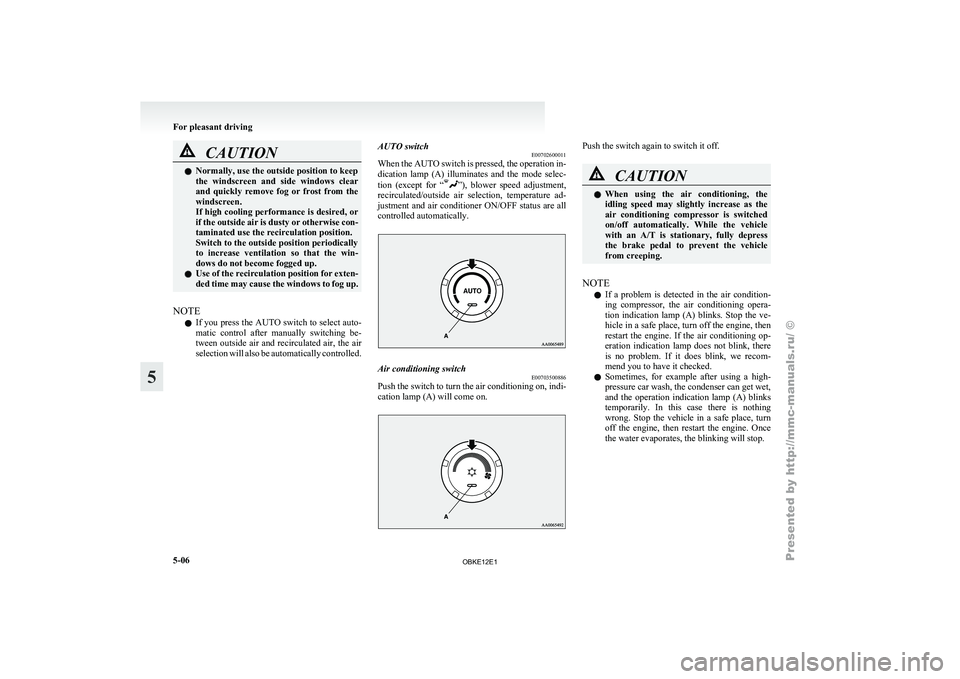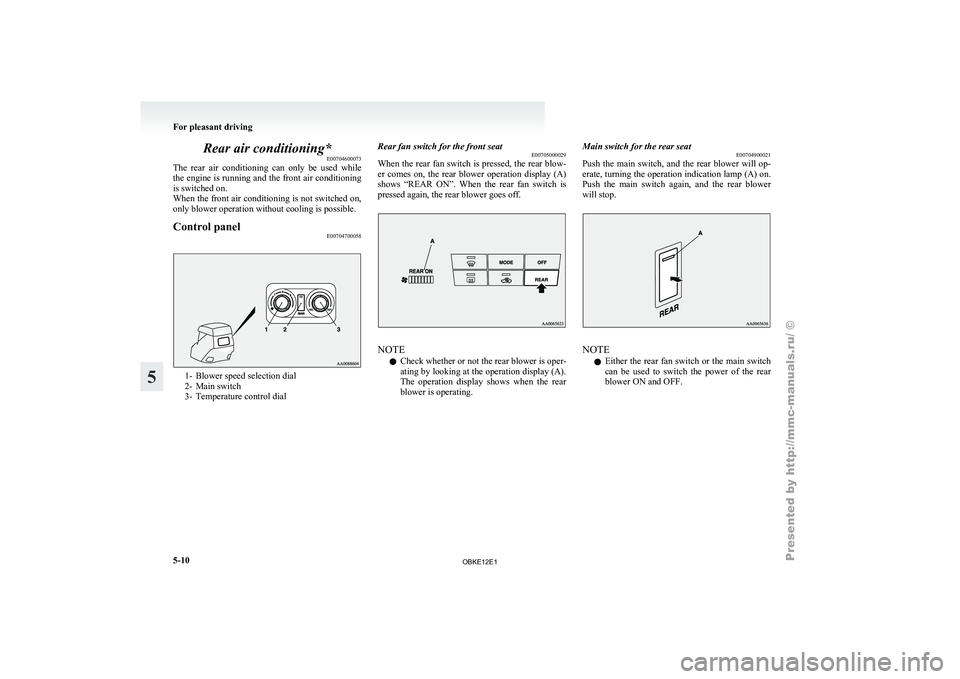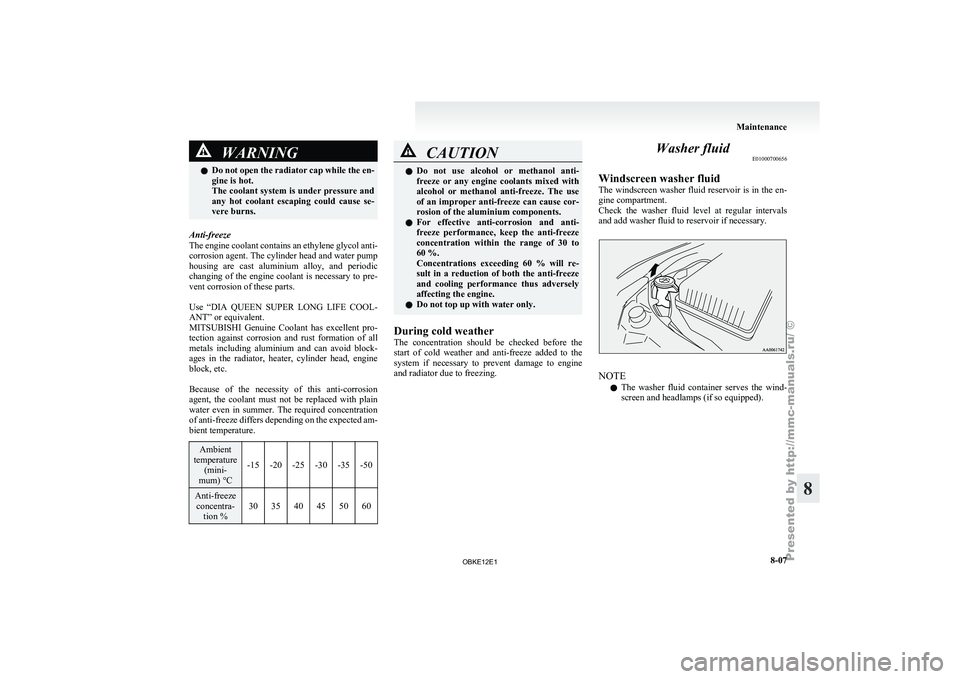cooling MITSUBISHI PAJERO IV 2011 Owners Manual
[x] Cancel search | Manufacturer: MITSUBISHI, Model Year: 2011, Model line: PAJERO IV, Model: MITSUBISHI PAJERO IV 2011Pages: 377, PDF Size: 29.43 MB
Page 189 of 377

CAUTION
l
Normally, use the outside position to keep
the windscreen and
side windows clear
and quickly remove fog or frost from the
windscreen.
If high cooling performance is desired, or
if the outside air is dusty or otherwise con-
taminated use the recirculation position.
Switch to the outside position periodically
to increase ventilation so that the win-
dows do not become fogged up.
l Use of the recirculation position for exten-
ded time may cause the windows to fog up.
NOTE l If
you press
the AUTO switch to select auto-
matic control after manually switching be-
tween outside air and recirculated air, the air
selection will also be automatically controlled. AUTO switch
E00702600011
When the
AUTO
switch is pressed, the operation in-
dication lamp (A) illuminates and the mode selec-
tion (except for “ ”), blower speed adjustment,
recirculated/outside air
selection, temperature ad-
justment and air conditioner ON/OFF status are all
controlled automatically. Air conditioning switch
E00703500886
Push the switch to turn the air conditioning on, indi-
cation lamp (A) will come on. Push the switch again to switch it off.
CAUTION
l
When using
the air conditioning, the
idling speed may slightly increase as the
air conditioning compressor is switched
on/off automatically. While the vehicle
with an A/T is stationary, fully depress
the brake pedal to prevent the vehicle
from creeping.
NOTE l If
a problem
is detected in the air condition-
ing compressor, the air conditioning opera-
tion indication lamp (A) blinks. Stop the ve-
hicle in a safe place, turn off the engine, then
restart the engine. If the air conditioning op-
eration indication lamp does not blink, there
is no problem. If it does blink, we recom-
mend you to have it checked.
l Sometimes, for example after using a high-
pressure car wash, the condenser can get wet,
and the operation indication lamp (A) blinks
temporarily. In this case there is nothing
wrong. Stop the vehicle in a safe place, turn
off the engine, then restart the engine. Once
the water evaporates, the blinking will stop. For pleasant driving
5-06
5
OBKE12E1
Page 191 of 377

Foot position
Air flows mainly to the leg area.*: Optional equipment
Foot/Demister position
Air flows
to
the leg area, the windscreen and the
door windows.
*: Optional equipment Demister position
Air flows mainly
to the windscreen and the door
windows. Operating the system in automatic
mode
E00704100456 In normal conditions, use the system in the AUTO
mode and follow these procedures:
1. Push the AUTO switch. 2.
Select the
temperature control dial to the de-
sired temperature.
The mode
selection (except for “ ”), blow-
er speed adjustment,
recirculated/outside air
selection, temperature adjustment and air con-
ditioner ON/OFF status are all controlled au-
tomatically. CAUTION
l
For vehicles
with
A/T, while the vehicle is
stationary, fully depress the brake pedal
to prevent the vehicle from creeping
caused by slightly increased idling speed
when the air conditioning compressor is
switched on automatically.
NOTE l When
the temperature
is set to the highest or
the lowest setting under the AUTO opera-
tion, the air selection and the air conditioning
will be automatically changed as follows.
Also, if the air selection is operated manually
after an automatic changeover, manual oper-
ation will be selected. • Quick Heating (When the temperature isset to the highest setting)
Outside air will be introduced.
• Quick Cooling (When the temperature is set to the lowest setting)
Inside air will be recirculated and the air
conditioning will operate. For pleasant driving
5-08
5
OBKE12E1
Page 193 of 377

Rear air conditioning*
E00704600073
The rear air
conditioning can only be used while
the engine is running and the front air conditioning
is switched on.
When the front air conditioning is not switched on,
only blower operation without cooling is possible.
Control panel E007047000581- Blower speed selection dial
2- Main switch
3-
Temperature control dial Rear fan switch for the front seat
E00705000029
When the rear
fan switch is pressed, the rear blow-
er comes on, the rear blower operation display (A)
shows “REAR ON”. When the rear fan switch is
pressed again, the rear blower goes off. NOTE
l Check whether or not the rear blower is oper-
ating
by looking
at the operation display (A).
The operation display shows when the rear
blower is operating. Main switch for the rear seat
E00704900021
Push the main
switch, and the rear blower will op-
erate, turning the operation indication lamp (A) on.
Push the main switch again, and the rear blower
will stop. NOTE
l Either
the rear
fan switch or the main switch
can be used to switch the power of the rear
blower ON and OFF. For pleasant driving
5-10
5
OBKE12E1
Page 194 of 377

Blower speed selection dial
E00705300019
The blower has
3 different speeds. Select the best
speed to fit your needs. Temperature control dial
E00705500066
Select the desired temperature level by turning
clockwise or anticlockwise. NOTE
l The
rear air
conditioning will not operate un-
less the front air conditioning compressor is
operating.
Always switch the front air conditioning com-
pressor on before using the rear air condition-
ing. If the front air conditioning compressor
is not operating, the system will just operate
as a blower. Important operation tips for the
air conditioning E00708300889
l Park the vehicle in the shade.
Parking
in
the
hot sun will make the vehicle
inside extremely hot, and it will require more
time to cool the interior.
If it is necessary to park in the sun, open the
windows for the first few minutes of air con-
ditioning operation to expel the hot air.
l Close the windows when the air conditioning
is in use. The entry of outside air through
open windows will reduce the cooling effi-
ciency.
l Too much cooling is not good for the health.
The inside air temperature should only be 5
to 6 °C below the outside air temperature.
l When operating the system, make sure the
air intake, which is located in front of the
windscreen, is free of obstructions such as
leaves and snow. Leaves collected in the air-
intake plenum may reduce air flow and plug
the plenum water drains.
Air conditioning system refrigerant
and lubricant recommendations
If the air conditioning seems less effective than usu-
al, the cause might be a refrigerant leak. We recom-
mend you to have the system inspected.
The air conditioning system in your vehicle must
be charged with the refrigerant HFC-134a and the
lubricant ND-OIL8.
Use of any other refrigerant or lubricant will cause
severe damage which will result in the need to re-
place your vehicle’s entire air conditioning system.
The release of refrigerant into the atmosphere
should be prevented. For pleasant driving
5-11 5
OBKE12E1
Page 285 of 377

CAUTION
l
Take care not to get the jumper cable
caught in the cooling fan or other rotat-
ing part in the engine compartment.
l Use the proper cables suitable for the bat-
tery size to prevent overheating of the ca-
bles.
l Check the jumper cables for damage and
corrosion before use.
7. Start the engine in the vehicle which has the
booster battery,
let the engine idle a few mi-
nutes, then start the engine in the vehicle
with the discharged battery. CAUTION
l
Keep the engine
of the vehicle giving assis-
tance running.
8. After the engine is started, disconnect the ca-
bles in
the reverse order and keep the engine
running for several minutes. WARNING
l If the
battery
has to be charged while fit-
ted in the vehicle, disconnect the vehicle
side negative (-) terminal connected to the
battery.
l Keep sparks, cigarettes and flames away
from the battery because the battery may
produce an explosion.
l Use adequate ventilation when charging
or using the battery in an enclosed space. WARNING
l Remove all the
caps before charging the
battery.
l Electrolyte is corrosive diluted sulphuric
acid. If electrolyte (battery acid) comes in-
to contact with your hands, eyes, clothes
and the painted surface of your vehicle, it
should be thoroughly flushed with water.
If electrolyte gets in your eyes, flush them
with water immediately and thoroughly,
and get prompt medical attention.
NOTE l If
the vehicle
is put in motion without fully
charging the battery, it might cause the loss
of smooth engine operation and the anti-lock
brake warning lamp to illuminate. Refer to
“Anti-lock brake system (ABS)” on page
4-39. Engine overheating
E00800600991
If the water
temperature gauge indication remains
in the overheating zone for a long time, the engine
may be overheating. If this occurs, take the follow-
ing corrective measures: 1. Stop the vehicle in a safe place.
2. Check whether steam is coming from the en-gine compartment.
[If steam does not come from the engine com-
partment]
With the engine still running, raise the bon-
net to ventilate the engine compartment.
[If steam is coming from the engine compart-
ment]
Stop the engine, and when the steam stops,
raise the bonnet to ventilate the engine com-
partment. Restart the engine. WARNING
l Do not
open
the bonnet while steam is com-
ing from the engine compartment. It
could cause steam or hot water to spurt
out, causing burns. Hot water could spurt
out even when there is no steam coming
out, and some parts will be very hot. Be
very careful when opening the bonnet.
l Be careful of hot steam, which could be
blowing off the reserve tank cap.
l Do not attempt to remove the radiator
cap while the engine is hot. For emergencies
6-04
6
OBKE12E1
Page 286 of 377

3. Confirm that the cooling fan is turning. If the
fan is not turning, stop the engine immediate-
ly and have it checked.Front A- Radiator cap
B- Cooling fan
C- Reserve tank
* : If so equipped WARNING
l Be careful
not
to get your hands or
clothes caught in the cooling fan. 4. After the engine coolant temperature has drop-
ped to
the normal temperature, stop the engine. 5. Check the coolant level in the reserve tank (A).
WARNING
l If there
is
none, make sure that the en-
gine has cooled down before removing
the radiator cap (B), because hot steam
or boiling water otherwise will gush from
the filler port and may scald you. 6. Add coolant to the radiator and/or reserve
tank if
necessary. (Refer to the “Mainte-
nance” section.) CAUTION
l
Do not
add
coolant while the engine is
hot. Suddenly adding cold coolant could
damage the engine. Wait for the engine to
cool down, then add coolant a little at a
time.
7. Examine the radiator hoses for coolant leak-
age and
the drive belt for looseness or damage.
If there is anything wrong with the cooling
system or drive belt, we recommend you to
have it checked and repaired. For emergencies
6-05 6
OBKE12E1
Page 313 of 377

NOTE
l Use
of additives
is not recommended since
they may reduce the effectiveness of addi-
tives already included in the engine oil. It
may result in failure of the mechanical assem-
bly.
Vehicles with diesel particulate filter (DPF) l
Select engine
oil
of the proper SAE viscosity
number according to the atmospheric temper-
ature.
l Use engine oil conforming to the following
classification:
• ACEA classification:“For service C1, C2, C3 or C4”
• JASO classification: “For service DL-1”
If those classifications are not available, con-
tact a MITSUBISHI MOTORS Authorized
Service Point. NOTE
l Use
of additives
is not recommended since
they may reduce the effectiveness of addi-
tives already included in the engine oil. It
may result in failure of the mechanical assem-
bly. Engine coolant
E01000501273
To check the coolant level
A translucent
coolant
reserve tank is located in the
engine compartment.
The coolant level in this tank should be kept be-
tween the “LOW” and “FULL” marks when meas-
ured while the engine is cold. To add coolant
The cooling
system
is a closed system and normal-
ly the loss of coolant should be very slight. A no-
ticeable drop in the coolant level could indicate leak-
age. If this occurs, we recommend you to have the
system checked as soon as possible.
If the level should drop below the “LOW” level on
the reserve tank, open the lid and add coolant.
Also, if the reserve tank is completely empty, re-
move the radiator cap and add coolant until the lev-
el reaches the filler neck. Maintenance
8-06
8
OBKE12E1
Page 314 of 377

WARNING
l Do not open the radiator cap while the en-
gine is hot.
The coolant system is under pressure and
any hot coolant escaping could cause se-
vere burns.
Anti-freeze
The engine coolant
contains an ethylene glycol anti-
corrosion agent. The cylinder head and water pump
housing are cast aluminium alloy, and periodic
changing of the engine coolant is necessary to pre-
vent corrosion of these parts.
Use “DIA QUEEN SUPER LONG LIFE COOL-
ANT” or equivalent.
MITSUBISHI Genuine Coolant has excellent pro-
tection against corrosion and rust formation of all
metals including aluminium and can avoid block-
ages in the radiator, heater, cylinder head, engine
block, etc.
Because of the necessity of this anti-corrosion
agent, the coolant must not be replaced with plain
water even in summer. The required concentration
of anti-freeze differs depending on the expected am-
bient temperature. Ambient
temperature (mini-
mum) °C -15 -20 -25 -30 -35 -50 Anti-freeze
concentra- tion % 30 35 40 45 50 60 CAUTION
l
Do not use
alcohol or methanol anti-
freeze or any engine coolants mixed with
alcohol or methanol anti-freeze. The use
of an improper anti-freeze can cause cor-
rosion of the aluminium components.
l For effective anti-corrosion and anti-
freeze performance, keep the anti-freeze
concentration within the range of 30 to
60 %.
Concentrations exceeding 60 % will re-
sult in a reduction of both the anti-freeze
and cooling performance thus adversely
affecting the engine.
l Do not top up with water only.
During cold weather
The concentration should
be checked before the
start of cold weather and anti-freeze added to the
system if necessary to prevent damage to engine
and radiator due to freezing. Washer fluid
E01000700656
Windscreen washer fluid
The windscreen washer
fluid reservoir is in the en-
gine compartment.
Check the washer fluid level at regular intervals
and add washer fluid to reservoir if necessary. NOTE
l The
washer fluid
container serves the wind-
screen and headlamps (if so equipped). Maintenance
8-07 8
OBKE12E1